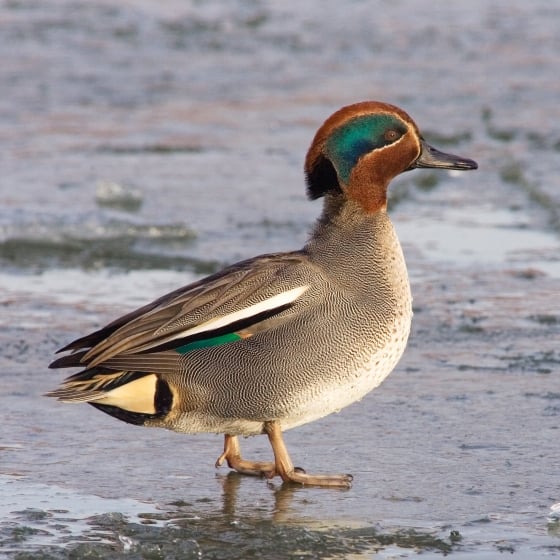Teal
Anas crecca (Linnaeus, 1758)
T.
 TEAL.
TEAL.  1840
1840

Family: Anseriformes > Anatidae

The Teal is our smallest duck and its bright green wing flash can be seen in marshlands across the UK.
This is an uncommon breeding bird in the UK, with an estimated population of just 4,000 pairs but this population is dwarfed by the winter arrival of around half a million birds from the Continent. At this time the male Teal is at his most resplendent, with a gilt-edged, chestnut and green head and a butter-yellow triangle beneath the tail. The scalloped, brown female shares the bright green wing flash of the male.
Wetland Bird Survey results show an upward trend for Teal across the UK and, unsurprisingly, that numbers peak between October and February. Since the 1968–72 breeding atlas, however, there has been a 14% decrease in the size of the breeding range in Britain.
Identification
Teal identification is often straightforward. The following article may help when identifying Teal.
Identifying female dabbling ducks

Ducks are usually easy to identify, but the females can be more challenging. Many of our familiar dabbling ducks have subtly-plumaged brown females which, on first glance, appear similar. This workshop will help you tell them apart with confidence.
- ‹ previous
- 2 of 2
Develop your bird ID skills with our training courses
Our interactive online courses are a great way to develop your bird identification skills, whether you're new to the hobby or a competent birder looking to hone your abilities.
Browse training coursesStatus and Trends
Population size and trends and patterns of distribution based on BTO surveys and atlases with data collected by BTO volunteers.
CONSERVATION STATUS
This species can be found on the following statutory and conservation listings and schedules.
POPULATION CHANGE
Although much more abundant as a winter visitor, the Teal has a small breeding population of 2,700 to 4,750 breeding pairs (APEP4), with breeding numbers having increased since the time of the 1988–91 Breeding Atlas. However, the status is complicated by the presence of wintering and migrant birds until the end of April, and there has been a 14% range decrease since the 1968–72 Breeding Atlas; hence the longer term trend is unknown.
| UK winter population |
+11% increase (1996/97–2021/22)  |
DISTRIBUTION
In winter Teal are widespread throughout Britain & Ireland, being found in a variety of coastal and freshwater sites from small pools to large estuaries. The breeding season distribution map is distorted by the continued presence of wintering birds through to the end of April. Breeding Teal are patchily distributed in southern Britain and in Ireland.
Occupied 10-km squares in UK
| No. occupied in breeding season | 1224 |
| % occupied in breeding season | 41 |
| No. occupied in winter | 2274 |
| % occupied in winter | 75 |
European Distribution Map
DISTRIBUTION CHANGE
Change in occupied 10-km squares in the UK
| % change in range in breeding season (1968–72 to 2008–11) | -16.5% |
| % change in range in winter (1981–84 to 2007–11) | +12.9% |
SEASONALITY
Teals are common winter visitors, recorded on up to 20% of lists but scarce in summer when there is a small over-summering population and small numbers breed.

Movement
Information about movement and migration based on online bird portals (e.g. BirdTrack), Ringing schemes and tracking studies.
An overview of year-round movements for the whole of Europe can be seen on the EuroBirdPortal viewer.
RINGING RECOVERIES
View a summary of recoveries in the Online Ringing Report.
Foreign locations of birds ringed or recovered in Britain & Ireland

Biology
Lifecycle and body size information about Teal, including statistics on nesting, eggs and lifespan based on BTO ringing and nest recording data.
SURVIVAL & LONGEVITY
View number ringed each year in the Online Ringing Report
Maximum Age from Ringing 
|
18 years 0 months 20 days (set in 1988) 
|
Typical Lifespan 
|
3 years with breeding typically at 1 year |
Adult Survival 
|
0.53 (Male: 0.55±0.022 Female: 0.51±0.057)  
|
BIOMETRICS
Wing Length 
|
Adults | 187.2±7.5 | Range 177–196mm, N=5504 |
| Juveniles | 186.4±5.7 | Range 177-195mm, N=7902 | |
| Males | 190.5±7.2 | Range 183–197mm, N=3314 | |
| Females | 182.2±4.5 | Range 175–190mm, N=2170 |
Body Weight 
|
Adults | 323±60.6 | Range 260–395g, N=5181 |
| Juveniles | 296±34.7 | Range 245–355g, N=7715 | |
| Males | 336±41.4 | Range 275–400g, N=3121 | |
| Females | 303±77.6 | Range 245–360g, N=2048 |
Feather measurements and photos on featherbase 
CODES & CLASSIFICATION
Ring size 
|
E* |
Field Codes 
|
2-letter: T. | 5-letter code: TEAL. | Euring: 1840 |
For information in another language (where available) click on a linked name
Research
Interpretation and scientific publications about Teal from BTO scientists.
CAUSES AND SOLUTIONS
Causes of change
The trend for the breeding population is uncertain and hence the drivers of change are also unclear.
PUBLICATIONS (1)

High pathogenicity avian influenza: Targeted active surveillance of wild birds to enable early detection of emerging disease threats
A different approach could provide warning of avian influenza outbreaks
Although we lack complete understanding of the disease links between wild and captive bird populations, the pattern of HPAI emergence in captive poultry reflects the movements of migratory waterfow
Links to more studies from ConservationEvidence.com
Would you like to search for another species?














Share this page